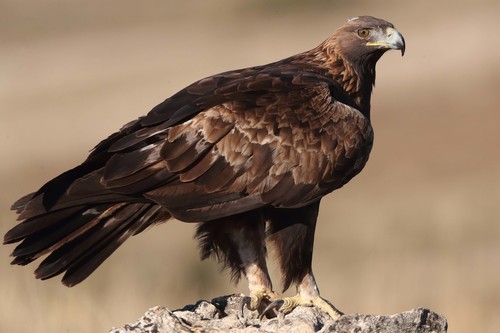
Golden Eagle
The Golden Eagle (Aquila chrysaetos) is one of the most recognizable and widely distributed birds of prey in the Northern Hemisphere. Renowned for its impressive size, speed, and powerful talons, it holds a significant place in various cultures, often symbolizing strength, courage, and freedom. Ecologically, it plays a crucial role as an apex predator, helping to regulate populations of smaller animals and maintaining ecosystem balance. Its adaptability has allowed it to thrive in diverse habitats, from mountainous regions to open grasslands.
70-84 cm
Length
185-220 cm
Wingspan
Least Concern
Conservation Status
Distribution
Found across North America, Europe, Asia, and parts of North Africa. Migratory patterns vary; some populations are resident year-round, while others migrate south for the winter. They can be found at altitudes ranging from sea level to over 4,000 meters.
Lifespan
Typically 15-20 years in the wild, but can live longer in captivity (up to 30 years or more).
Golden Eagle's Habitat
Habitat Types
Mountains, Open grasslands, Tundra, Coniferous forests, Deserts
Climate Zones
Temperate, Boreal, Arid, Arctic
Adaptations
Golden Eagles possess exceptional eyesight, allowing them to spot prey from great distances. Their large wingspans enable efficient soaring over vast areas, conserving energy during hunting. Their powerful talons are perfectly adapted for grasping and killing prey.
Variations
Several subspecies are recognized, differing slightly in size and plumage. For example, North American Golden Eagles (A. c. canadensis) are generally larger than their Eurasian counterparts.
Appearance
Breeding Plumage
Adult plumage is largely consistent year-round.
Seasonal Feather Changes
Minimal seasonal variation in adult plumage.
Sex Based Plumage Differences
Males and females have similar plumage, primarily dark brown with golden-brown feathers on the head and nape (giving them their name).
Notable Features
Golden-brown feathers on the nape and crown., Powerful, hooked beak., Large, sharp talons., Dark brown overall plumage.
Diet and Feeding
Primary Foods
Rabbits, Hares, Ground squirrels, Marmots, Birds (occasionally), Reptiles (occasionally)
Foraging Behavior
Golden Eagles primarily hunt by soaring high above the ground and using their keen eyesight to spot prey. They may also perch on vantage points or hunt from low flight. They employ a swift, powerful dive to capture their prey.
Specializations
Their exceptional eyesight, powerful talons, and high-speed diving ability are key specializations for hunting.
Seasonal Diet Variations
Diet can vary seasonally depending on prey availability. For example, in areas with harsh winters, they may rely more on carrion when live prey is scarce.
Behavior
Social Structure
Generally solitary or found in pairs, except during migration or at abundant food sources where larger groups may temporarily congregate.
Communication
Vocalizations (various calls, including a 'kee-kee-kee' alarm call), Aerial displays (for courtship and territorial defense), Body postures (e.g., raising head feathers)
Migration
Some populations are migratory, traveling long distances between breeding and wintering grounds. Others are resident year-round. Migration routes and timing vary depending on geographic location and food availability.
Territorial or Group Behaviors
Golden Eagles are highly territorial, defending large territories that can encompass many square kilometers. Pairs maintain their territories year-round.
Conservation
Threats
Habitat loss and degradation, Lead poisoning (from ingesting lead shot in carcasses), Collisions with wind turbines and power lines, Human persecution (illegal shooting and trapping), Pesticide exposure
Protection Programs
CITES Appendix II (regulates international trade), National wildlife refuge systems, Monitoring and research programs, Habitat restoration projects, Public education campaigns
Local National Laws
Protected under various national laws, such as the Bald and Golden Eagle Protection Act in the United States and similar legislation in other countries.
Population Trend
Stable
Population Estimates
Global population estimated to be between 170,000 and 250,000 individuals.
Interesting Facts
Golden Eagles can reach diving speeds of up to 200 mph (320 km/h).
This makes them one of the fastest animals on Earth, allowing them to capture fast-moving prey.
They have been used in falconry for centuries.
Their hunting prowess and trainability have made them prized birds in falconry traditions across various cultures.
Golden Eagle nests (eyries) can be enormous.
Pairs often reuse the same nest year after year, adding to it each season. Some nests can reach over 10 feet wide and 20 feet deep.
They can see ultraviolet light
This ability likely helps them detect urine trails of prey, making it easier to locate them in dense vegetation.
Faqs about Golden Eagle
What is the difference between a Golden Eagle and a Bald Eagle?
Adult Bald Eagles have a distinctive white head and tail, while Golden Eagles are primarily dark brown with golden feathers on the head and nape. Juvenile Bald Eagles can be confused with Golden Eagles, but they lack the golden nape and have more mottled brown and white plumage.
Do Golden Eagles attack humans?
Attacks on humans are extremely rare. Golden Eagles generally avoid humans and pose little threat unless provoked or defending their nests.
Where can I see Golden Eagles?
Golden Eagles can be found in a variety of open habitats, including mountains, grasslands, and tundra. National parks and wildlife refuges in their range are good places to look for them. Binoculars or a spotting scope are recommended for viewing.
How can I help Golden Eagle conservation?
You can support conservation efforts by donating to organizations that protect birds of prey, advocating for habitat preservation, and avoiding the use of lead ammunition (if you hunt). Reporting any injured or dead eagles to local wildlife authorities is also crucial.
Copyright @ Nature Style Limited. All Rights Reserved.
 English
English